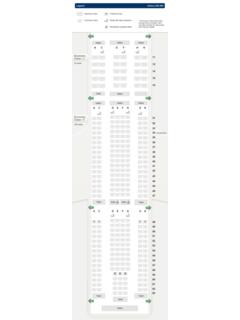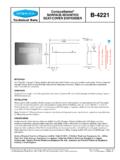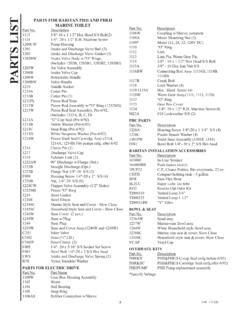Transcription of Successful Toilet Training and Beyond PDF - …
1 Successful Toilet Training and BeyondSuccessful Toilet Successful Toilet Training and BeyondTraining and BeyondAnna Edwards, , Clinical Child PsychologistAnna Edwards, , Clinical Child PsychologistKristen Michener, , Clinical Child PsychologistKristen Michener, , Clinical Child PsychologistMade For Kids, For Kids, Most children have the muscle control to regulate themselves between 18 months and 3 years of age. Children with disabilities or certain medical problems may not have this ability until later. On average children are fully day trained between ages 2 and 4. Night Training for wetting is much more variable, between the ages of 3 and the Stage for Success Pre- Toilet Training prepares your child for Toilet Training and will make the process easier for you.
2 You can begin this process when your child is around 15 months or older. You should continue until your child demonstrates some of the readiness signals that will be talked about in the next section. If your child is ready to begin Toilet Training now, spend at least a week practicing pre- Toilet Training skills so that your child becomes familiar with the process. Setting the Stage for Success, cont d Name urine and bowel movements: When your child has a dirty diaper, mention what has happened using words that you have chosen ( , You have poopoo in your diaper ). Model the use of the Toilet : This involves allowing your child to watch you and other family members use the Toilet so that they can see, ask questions and learn.
3 Setting the Stage for Success, cont d Change diapers quickly: Change your child s diapers as soon as it becomes wet or dirty so that your child does not become comfortable with wet or dirty diapers. Try to change diapers in the bathroom if possible and drop the discards in the Toilet , so that your child may learn where poopoos go. Also, encourage your child to flush the Toilet so that she may learn how. Do not make your child feel bad for wetting or soiling her the Stage for Success, cont d Praise your child: Praise your child when he verbally tells you or with a gesture that he has urinated or soiled the diaper.
4 You should also praise your child for cooperating with any of the above When your child is readyYour child may be ready to begin Toilet Training if he/she: Has regular, soft, formed bowel movements Imitates others bathroom habits ( , likes to watch you go to the bathroom, wants to wear underwear) Makes physical demonstration when he/she is having a bowel movement ( , grunting, squatting) Has words or gestures for urine and bowel movementsWhen your child is ready, cont d Is able to follow simple instructions Can inform, by words or gestures that he/she has to urinate or have a bowel movement before it happens Does not like the feeling of a dirty diaper Has dry diapers or underwear for at least 2-3 hours Can walk and sit downWhen your child is ready, cont d Your child s bowel movements become regular and predictable.
5 Your child can take his or her pants on and off and walk to and from the bathroom with ease. Your child asks to use the Toilet or the potty chair. Your child asks to wear big kids pants , pull-ups, or underwear instead of diapers. How long does Training Take?How Long Does Toilet Training Take? Once you begin Toilet Training it may take children 3 to 4 weeks before they are mostly dry during the day For some children it may take several months. Many children still accidentally wet or soil their pants up to a year after Training begins. Most children find that learning to urinate in the Toilet is easier than passing a bowel movement and it may take children longer to learn to pass a bowel movement in the Toilet .
6 Getting ready for we go!Getting ready for Training Find your child s pattern, their schedule or routine. Keep track of the times during the day when your child usually wets or passes bowel movements. Begin to sit your child on the Toilet during those times when you begin Training . Get everything ready that you need. You can use a potty or the Toilet for Training . If you choose to use the Toilet , get a Toilet seat ring so that your child will not be afraid of failing in. Also provide your child with support under their feet ( , a stool or stable step). Getting ready for Training , cont d Help your child get ready.
7 Only use diapers when your child is sleeping. Diapers are a sign that it is all right to wet or pass a bowel movement. Put your child in underwear. The feeling of wet underwear may help your child realize when they are wet. Training underwear made of thicker material may be helpful. Getting ready for Training , cont d Dress your child in loose clothing. Clothing without fasteners or buttons is easier for children to get on and off. Talk to your child about the potty and what it is for. You may want to let your child do a special activity ( , like playing with a favorite toy) while they practice sitting on the potty.
8 We all learn by watching others. Let your child follow you into the bathroom to see the steps that you go through when using the Toilet . Talk to your child about what you are doing. I m now how do I do it?Potty Training 101 There are several steps involved in Toilet Training . Keep in mind that your child should feel comfortable with each step before moving on to the Training 101 Choose a concrete time to begin It is important to be consistent and follow the same toileting routine every day when you begin Toilet Training . To start Toilet Training , set aside half of a day when you will be home and choose a time when your family is relaxed.
9 Give your child plenty to drink. On the first day of Training giving your child more to drink helps to increase the chance that you child will want to use thebathroom, but do not force your child to drink. Also, make sure that your child s diet has plenty of fruits and fibers to keep bowel movements soft. Potty Training 101 Step 1: Keep track of when your child urinates and has bowel movements so that you identify her elimination pattern. Continue to obtain this information while implementing steps 2 and 3. Potty Training 101 Step 2: Begin to introduce the potty to your child. Place a potty chair in the bathroom and wait for your child to inquire about it.
10 This gives your child a sense of control and lets him initiate the Training . This also avoids negative comments such as No, I don t wanna see potty. Potty Training 101 Step 3: Have your child sit on the potty a few times a day with her clothes on. This will get your child in the habit of sitting on the potty. Encourage your child to sit on the potty. You can do this by providing a special activity to do ( , playing with a favorite toy or game) or giving a special treat such as stickers or M&M s for sitting on the potty. Potty Training 101 Only allow that desirable activity to occur when your child sits on the potty.








